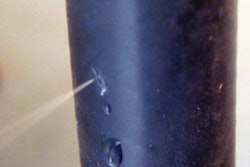Rob Shimko, product sales manager for Parker Hannifin's Hydraulic Valve Division, understands all too well the dangers of hydraulic injection injury. "My injury happened in the blink of an eye when my left hand was blown back from a pressurized valve," he recalls. "At first, it looked harmless - just a red mark, and no pain to speak of.
"The doctor treated my injury like a burn, with salve and a bandage, and sent me home," he continues. "That's when I remembered seeing injection injury warnings printed in an old service manual. I found it and took it back to the hospital, which led to the scheduling of immediate surgery. Fortunately, [surgery] wasn't necessary, but a $6,000 skin graft to repair the damage was."
Injection injuries demand immediate treatment. Hydraulic fluid can quickly destroy tissue, leading to gangrene and the need to amputate (as occurs in nearly half of all instances). Yet, simply rushing the injured person to the nearest hospital may not be adequate.
Because the initial presentation of the wound appears harmless, the treatment protocol is often given a mistakenly low priority. In addition, many doctors are not experienced in treating injection injuries. It may take hours to locate a qualified medical professional. Time wasted can cost the injured person his or her limb (or life) - reinforcing the importance of proper pre-emergency planning.
Begin planning now for proper treatment. Locate a practiced caregiver proficient in the treatment of injection injuries (a hand surgeon is the most likely candidate), then issue each employee a wallet card with the address and phone number of the medical facility and/or surgeon. (Parker offers pre-printed "Fast Response for Injection Injuries" wallet cards through its SafetyWorks program.) In the event of an injury, on the back of the card, list the critical information that must be relayed, including type, amount and pressure of the fluid injected, as well as the exact time, body location and penetration angle of the injury.
"I cannot stress enough," says Shimko, "the importance of properly diagnosing injection injuries and treating them with the greatest possible urgency."
Information provided by Parker Hannifin Corp. Fluid Connectors Group.



















